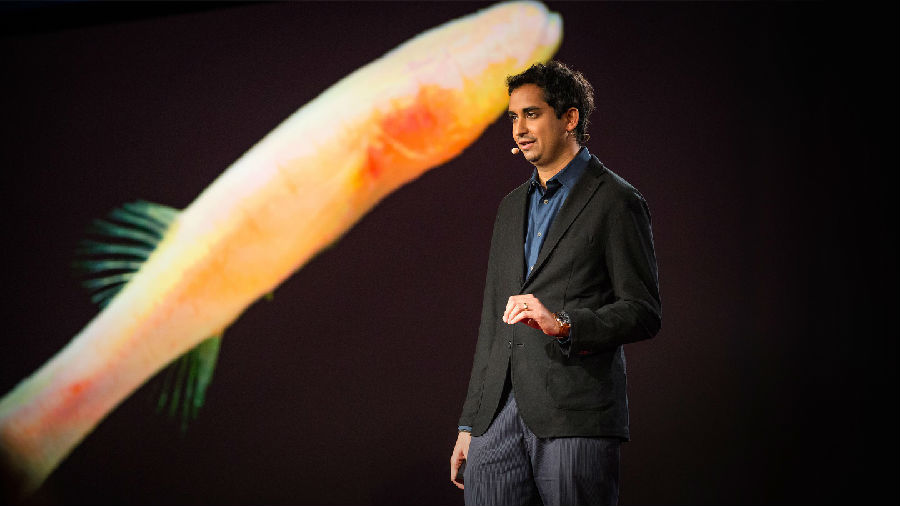(单词翻译:单击)
Ichthyology, the study of fishes. It looks like a big, boring word,
鱼类学是研究鱼类的学科。这个词看着很笼统,很无聊,
but it's actually quite exciting, because ichthyology is the only "ology" with "YOLO" in it.
但其实还是挺有趣的,因为这个词是唯一个学科名里带有"YOLO"的。
Now, to the cool kids in the audience, you already know, YOLO stands for "you only live once,"
对于台下很时髦的年轻人来说,你们已经知道"YOLO"这个缩写代表着"你只能活一次",
and because I only have one life, I'm going to spend it doing what I always dreamt of doing:
因为我只能活一次,所以我要把它用在我真正梦想的事情:
seeing the hidden wonders of the world and discovering new species. And that's what I get to do.
去探索世界的未知,去发现新的物种。那就是我要做的事情。
Now, in recent years, I really focused on caves for finding new species.
最近这几年,我的研究重点放在了洞穴中新物种的发现上。
And it turns out, there's lots of new cavefish species out there.
我们发现那里面确实有很多新种类的洞穴鱼。
You just have to know where to look, and to maybe be a little thin.
你只需要知道去哪里找就行了,可能还要身材苗条一点。
Now, cavefishes can tell me a lot about biology and geology.
洞穴鱼类能够告诉我许多生物学和地理学的信息。
They can tell me how the landmasses around them have changed and moved by being stuck in these little holes,
透过它们居住的小洞穴,我们可以研究大陆板块的改变及漂移;
and they can tell me about the evolution of sight, by being blind.
透过它们的盲眼,让我们了解到视觉的演化过程。
Now, fish have eyes that are essentially the same as ours.
一般而言,鱼类都有眼睛,跟我们一样。
All vertebrates do, and each time a fish species starts to adapt to this dark, cold, cave environment,
所有的脊椎动物本来都有眼睛,但是当生存环境变了,如果一种鱼要适应阴冷的洞穴环境,
over many, many generations, they lose their eyes and their eyesight until the end up like an eyeless cavefish like this one here.
经过一代又一代的演化,这些鱼的视力逐渐退化,现在的洞穴鱼类已经没有眼睛了。
Now, each cavefish species has evolved in a slightly different way,
每种洞穴鱼的演化方式都不太一样,
and each one has a unique geological and biological story to tell us,
而且每种都在诉说着其独特的生物、地质学故事。
and that's why it's so exciting when we find a new species.
这就是为什么每当发现新的物种,我们都很兴奋的原因。
So this is a new species we described, from southern Indiana.
这是我们从印第安纳南部发现的一个新物种。
We named it Amblyopsis hoosieri, the Hoosier cavefish.
我们叫它"Amblyopsis hoosieri",就是印第安纳洞穴鱼的意思。
Its closest relatives are cavefishes in Kentucky, in the Mammoth Cave system.
它的近亲是肯塔基州的一种洞穴鱼,生活在猛犸洞穴系统中。
And they start to diverge when the Ohio River split them a few million years ago.
几百万年前,因俄亥俄河而被分开的它们,开始出现不同。
And in that time they developed these subtle differences in the genetic architecture behind their blindness.
那段期间,它们的遗传结构产生细微差异的演化,造成其失明的原因也各异。
There's this gene called rhodopsin that's super-critical for sight.
有一种名叫"视紫红质"的基因,对于视觉超级重要。

We have it, and these species have it too, except one species has lost all function in that gene, and the other one maintains it.
人类和这些鱼类都有同样的基因,但是有种洞穴鱼在进化中完全丢掉了这个基因,而其它的洞穴鱼类还保留着。
So this sets up this beautiful natural experiment where we can look at the genes behind our vision, and at the very roots of how we can see.
大自然为我们做了完美的实验,使我们可以观察到视觉背后的基因奥秘,能够知道视觉感知的最根本原因。
But the genes in these cavefishes can also tell us about deep geological time, maybe no more so than in this species here.
而且这些洞穴鱼类的基因能够向我们提供深部地质年代的线索,可能没有谁比它们更能展示了。
This is a new species we described from Madagascar that we named Typhleotris mararybe.
这是我们在马达加斯加发现的新物种,取名为"Typhleotris mararybe"。
That means "big sickness" in Malagasy, for how sick we got trying to collect this species.
在马达加斯加语中是"大病"的意思,因为我们在试图采集该物种时,都生了大病。
Now, believe it or not, swimming around sinkholes full of dead things and cave full of bat poop
不管你信不信,在满布腐尸物的污水坑和充满着蝙蝠大便的洞穴内游泳,
isn't the smartest thing you could be doing with your life, but YOLO.
实在不是一件明智之举,但是,你只能活一次啊!
Now, I love this species despite the fact that it tried to kill us, and that's because this species in Madagascar,
尽管这种鱼差点害死我们,但我还是很爱它,因为这种生活在马达加斯加的鱼,
its closest relatives are 6,000 kilometers away, cavefishes in Australia.
最近的近亲是远在六千公里外的澳洲的洞穴鱼。
Now, there's no way a three-inch-long freshwater cavefish can swim across the Indian Ocean,
一条三英寸长的淡水洞穴鱼,是不可能游泳横越印度洋的,
so what we found when we compared the DNA of these species is that they've been separated for more than 100 million years,
所以我们在比较两者的DNA后发现,它们已经分开超过一亿年了,
or about the time that the southern continents were last together.
或者说是自南大陆板块漂移分裂后至今的时间。
So in fact, these species didn't move at all. It's the continents that moved them.
事实上,这两种物种根本没有搬家。是大陆板块移动了它们。
And so they give us, through their DNA, this precise model and measure of how to date and time these ancient geological events.
这些洞穴鱼类通过它们的DNA,为我们提供了精确的模型以及如何确定这些古地质事件的日期及时间的方法。
Now, this species here is so new I'm not even allowed to tell you its name yet,
这个物种非常新,我目前还不能公开它的名字,
but I can tell you it's a new species from Mexico, and it's probably already extinct.
但是我可以告诉大家,这是一种来自墨西哥的新物种,已经频临灭绝。
It's probably extinct because the only known cave system it's from was destroyed when a dam was built nearby.
是因为我们唯一知道可以发现它的洞穴系统,已经被附近的水坝工程摧毁了。
Unfortunately for cavefishes, their groundwater habitat is also our main source of drinking water.
很不幸,对洞穴鱼而言,它们的地下水栖息地,也是我们主要的饮用水源。
Now, we actually don't know this species' closest relative, yet.
我们其实还不知道这个物种最近的近亲。
It doesn't appear to be anything else in Mexico, so maybe it's something in Cuba, or Florida, or India.
墨西哥找不到任何相像的,所以很可能是在古巴、佛罗里达或印度。
But whatever it is, it might tell us something new about the geology of the Caribbean,
但不管是什么,它都可能告诉我们加勒比海地质的新发现,
or the biology of how to better diagnose certain types of blindness.
或帮助我们能更正确地诊断出生物失明的原因。
But I hope we discover this species before it goes extinct too.
但是,我也希望能在这物种灭绝前找到它。
And I'm going to spend my one life as an ichthyologist trying to discover and save these humble little blind cavefishes
身为鱼类学者,我要穷尽一生的努力,来发现并拯救这些不起眼的盲眼小洞穴鱼,
that can tell us so much about the geology of the planet and the biology of how we see. Thank you.
因为它们能告诉我们非常多地球的地质知识,以及我们是如何看到东西的相关生物学。谢谢。


